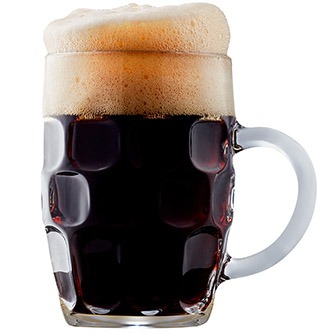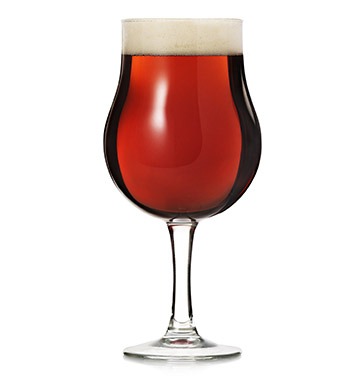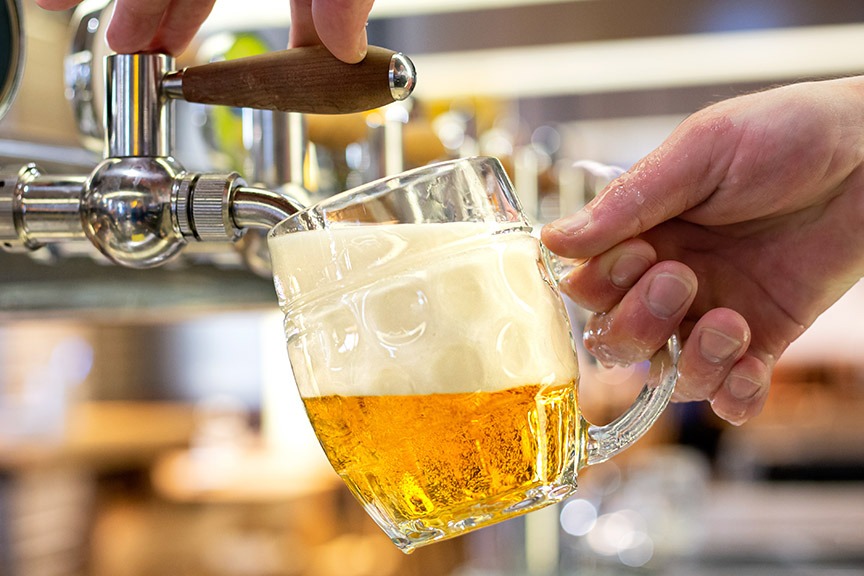Pivo, Please
History of Czech Beer
When American craft brewers discuss influences from other countries’ historical brewing traditions, you can expect them to mention England, Germany, and Belgium. But how many would include the Czech Republic (Czechia)? I have a feeling that many Americans think of Czech beer as just German beer made with soft water and Saaz hops. While those are certainly part of the story, there is a lot more to Czech beer than that.
České pivo (Czech beer) is actually recognized as a protected geographical indication (PGI) within the European Union, which gives it the weight of law. Its definition lists quality parameters, production methods, and ingredient limitations, as well as sensory aspects that distinguish it from other European beers. Not all beer in Czechia meets these criteria, but those that use the protected name certainly do. It’s like a trademark or appellation; it protects the intellectual property of the product, and guarantees that it meets defined quality standards.
While this all sounds like legalese, it does actually provide concrete evidence for something that I have been claiming for a long time — that Czech brewers have a tradition of decoction mashing, and it is an important part of their national beer character. Decoction mashing refers to removing a portion of the mash, typically a third, bringing that portion to a boil for a set time, and remixing it with the main mash to achieve a higher rest temperature The definition of České pivo mandates that a decoction mash (single, double, or triple) MUST be used. We’ll get into the other aspects of the beer, but this is very important.
Classification of Czech Beer
Czechia uses a matrix of color and original gravity (measured in degrees Balling, which is equivalent to degrees Plato and Brix) to classify beers. The colors are světlé (pale), tmavé (dark), and polotmavé (amber, or literally, half-dark). A small number of beers may be described as černé (black), but this is basically a synonym for dark. The gravity classes are known as stolní (table beer, less than 6 °Plato/1.023 OG), výčepní (draft, 7–10 °Plato/1.027–1.040 OG), ležák (lager, 11–12 °Plato/1.044–1.048 OG), and speciální (special, 13 °Plato/1.053 OG and greater). Porter is a subset of special beers that is a dark beer greater than 18 °Plato/1.074+ OG, but there are many other types of strong lager.
The use of gravity bands to define beers is not uniquely Czech — Germany uses a similar system of schankbier, vollbier, and starkbier. But the Czechs display the gravity more prominently, and often use the number as the name or identifier for the beer. The výčepní and ležák class beers are more commonly found, as are the světlé and tmavé colors.
You’ll notice that “Pilsner” isn’t used as a name of any of these beers, as it is in other countries. In Czechia, Pilsner means Pilsner Urquell, the beer from Plzeň (Pilsen). Similar beers are called světlé ležák, or pale lagers. Judges and brewers outside Czechia commonly call them either Czech Pilsners or Bohemian Pilsners, particularly when trying to distinguish them from German Pils or American Pilsners. As a sidenote, Pilsner is sometimes spelled Pilsener; both are correct.
The Beer Judge Certification Program (BJCP) differentiates výčepní beers as Czech pale lagers (Style 3A) and ležák as Czech premium pale lagers (Style 3B), avoiding the use of Pilsner as the style name out of respect for the origin of the style. The other defined Czech styles are Czech amber lager (Style 3C) and Czech dark lager (Style 3D). These are a subset of beers made in Czechia, but have been enough to drive interest in commercial brewers making these styles elsewhere.

The Czech styles listed in the BJCP guidelines represent a necessary collapsing of multiple categories of Czech beer to facilitate judging. Just be aware that the defined styles represent ranges of beers, and that multiple types of beer can fit within each category. As with most styles, the range of commercial examples can vary quite a bit, so it’s easy to find examples with differing balances, amounts of bitterness, and varying levels of sweetness or dryness in the finish.
Characteristics of Czech Beer
I tend to talk about Czech beer characteristics in both absolute and relative terms. Absolute when they can be quantified, but relative to German because they are often better known and serve as a useful frame of reference. To me, the biggest sensory difference about Czech beer compared to German is the mouthfeel. Czech beers have a fuller body and finish with a higher unfermented residual extract, which can sometimes be perceived as sweetness. Czechs describe their beer as having a fullness on the palate. On an absolute basis, the body is medium-to-full for many beers.
Czech beers are generally well-hopped and have a medium to high bitterness (standard-strength lagers can range up to 45 IBUs). The bitterness is not harsh, however, and the impression of bitterness is somewhat tempered by the fuller finish. Czech beer tends to have a higher finishing pH and polyphenol (tannin) level, which can also give a fuller mouthfeel and a reduced crispness.
Paler Czech lagers tend to have a deeper color than similar German beers due to decoction mashing, which often pushes them more into gold and even bronze and away from the straw to yellow colors of German lagers. Dark Czech lagers are rarely black, with dark brownish colors being the norm. Good clarity is prized, particularly in pale lagers.
Czech beers have a creamy head with a rich, natural foam, and are well carbonated. The foam is often accentuated by the characteristic Czech side pull taps (sometimes called LUKR taps, after the popular LUKR manufacturer that makes them). These taps have a ball valve that allows for a variable flow rate, as well as micro screens that normalize bubble size as the beer is dispensed. These features allow for pours with a varying amount of foam, which customers can request. Compare these to the standard North American beer tap faucet, often known as the Perlick style after the most common premium brand. Read more about the popular Czech pours in the sidebar below.
Check out our story on Czech beer pours for more on why the beer foam matters.
Producing Czech Beer
The ingredients in Czech beer produce much of the character and are specified within the PGI. The gold standard for hops is the Žatec (Saaz) variety and region, although hops from other Czech hop-growing areas are allowed. Whole hops are typically used. Dry hopping (or any cold-side hopping) is not used. First wort hopping — adding hops to the kettle before or during lautering, prior to the wort being brought to a boil — is a technique known to Czech brewers, and is often used to produce a smoother bitterness.

Pale malt of the Pilsner type from Czech regions is used. The English influence is present in the kilning methods, which aided in the development of the first pale lagers. As I previously mentioned, decoction mashing is required. Czechs believe that double decoction is preferable to single decoction, but some products (notably Pilsner Urquell) are still triple decocted. Czech malts tend to have lower levels of proteolytic modification, which favors a lower level of attenuation in the finished beer.
Compared to German beers, more caramel and dark malts are used in darker beers with less of a Munich/Vienna-type malt base. Pilsner-type malt (even if called “pale malt”) is the typical base. Richness is gained more through malting and decoction methods, which develop flavor as well as body and color. Roasted malts, when used, tend not to have burnt flavors. Czech beers are all malt; no sugars or adjuncts are used.
Water is described as soft-to-medium hard, with that from Pilsen being quite low in minerals. Bottom-fermenting lager yeast is used, with three common strains being available to Czech brewers. Their yeast strains tend to have lower attenuation than many German strains, and are often described as not being as “clean.” Czech beer can have a threshold buttery character from diacetyl that enhances caramel flavors and body when fresh, but should not have a strong or harsh quality. This profile tends to be desired by Czech consumers.
Czech beer undergoes a two-stage fermentation process, basically fermentation and lagering. The maximum fermentation temperature allowed is 57 °F (14 °C) but is traditionally cooler and slower, often below 50 °F (10 °C). Lagering is conducted at near-freezing temperatures and is often lengthy, until quality parameters are met. Open fermentation is still a technique practiced by many Czech brewers.
Historical Evolution
While there is evidence of brewing in Czechia for more than 1,000 years, modern Czech beer is inextricably linked to the Pilsner origin story. As we all know, Josef Groll first brewed Pilsner Urquell in 1842 in Plzeň, marking the start of popularizing pale lager. Using kilning techniques learned in England (then still the British Empire) and bottom-fermenting lager yeast obtained in Bavaria (then still a kingdom, as Germany didn’t become unified until 1871), local ingredients and Central European methods of the time were used to develop industrial brewing.

Czech beer continued to develop and expand in influence in Central Europe as lager brewing became more popular and consumer tastes for paler beer grew. However, modernization in brewing all but ceased in what was then-Czechoslovakia in the late 1930s as it first was occupied by Germany, and later came under communist control until the peaceful Velvet Revolution of 1989.
This unfortunate 40+ years of Czech history did have the effect of creating a kind of time capsule of brewing. Brewing in the Czech Republic of the 1990s resembled Bavarian brewing pre-WWII. This preservation of traditional beer production methods is one important aspect of modern Czech beer. While it is reasonable to see a common origin of German and Czech brewing traditions, the split almost a hundred years ago created differences that are still noticeable today. German brewing modernized and changed, while Czech brewing preserved many of the more historical and traditional ways that distinguish Czech beer today (learn more about Czech beer culture and the influence history has played in the sidebar below).
While there may not be explicit stylistic links between German and Czech beer, I often think about the parallel nature of many styles. Take a German/Austrian style of today and apply the Czech national character to get a modern Czech style: German Pils and Czech pale lager, German dunkel and Czech dark lager, Vienna lager and Czech amber lager, Baltic porter (or possibly doppelbock) and Czech porter. The cited styles, even more so when considering their strength variations, do reflect a national brewing character that is worth understanding and appreciating.
Read our article about industrial lagers in the Czech Republic for more on how the industry has evolved.
Final Comments
Prior to the 2015 BJCP Guidelines update that increased the awareness of traditional Czech styles beyond beers like Pilsner Urquell, it was often hard to find examples of Czech beers in the U.S. You could find some mentions in Michael Jackson’s books, but it was hard to find examples you could buy in stores or brewpubs. I’m happy to see so many U.S. (and elsewhere) craft breweries who are attempting Czech styles, especially those that are either specializing in them or in lager beer production in general.
I had wanted to introduce Czech styles (at least the dark lager) in the 2004 guidelines, but I was met with resistance because they either weren’t being entered in competitions or weren’t available as imports. I’m glad the BJCP has become more of an international organization since that has encouraged the exploration of more world beer styles and a better understanding of brewing traditions of important countries in the development of modern beer.
There is still more Czech beer to explore and understand, and the BJCP guidelines are just hitting some of the highlights at the moment. Don’t let the beer styles defined for homebrew competitions give you an incomplete understanding of the range of Czech beer. Those with a taste for travel can seek out local examples, of course. For those who wish to research further, the writings of Evan Rail, Ron Pattinson, and Jeff Alworth are always informative.

Czech Pale Lager
(5 gallons/19 L, all-grain)
OG = 1.048 FG = 1.012
IBU = 43 SRM = 5 ABV = 4.7%
Ingredients
9.75 lbs. (4.4 kg) Czech Pilsner (Bohemian pale ale) malt
8.6 AAU Czech Saaz hops (first wort hop) (2.25 oz./64 g at 3.8% alpha acids)}
2.9 AAU Czech Saaz hops (60 min.) (0.75 oz./21 g at 3.8% alpha acids)
1 oz. (28 g) Czech Saaz hops (whirlpool)
White Labs WLP802 (Czech Budejovice Lager), Wyeast 2000-PC (Budvar Lager), or Mangrove Jack’s M84 (Bohemian Lager) yeast
3⁄4 cup corn sugar (for priming)
Step by Step
This recipe uses reverse osmosis (RO) water. Adjust all brewing water to a pH of 5.5 using phosphoric acid. Add 1 tsp. of calcium chloride to the mash.
This recipe uses a double decoction mash, with some step mashing. Use enough water to have a moderately thin mash (2 qts./lb.). Mash in the Pilsner malt at 131 °F (55 °C) and hold for 10 minutes.
Pull the first decoction, resting it at 149 °F (65 °C) for 15 minutes and 162 °F (72 °C) for 15 minutes, before boiling for 15 minutes. Mix the decoction portion back with the main mash. The mash should now be at 149 °F (65 °C). Allow the mash to rest for 15 minutes.
Pull the second decoction, resting it at 162 °F (72 °C) for 15 minutes, before boiling for 15 minutes. Mix the decoction portion back with the main mash. The mash should now be at 162 °F (72 °C). Allow the mash to rest for 15 minutes.
Drain a thin portion of the mash, bring to a boil, and return to the main mash to raise the mash temperature to 170 °F (77 °C), then recirculate for 20 minutes.
Add the first wort hops to the kettle. Sparge slowly and collect 6.5 gallons (24.5 L) of wort. Boil the wort for 90 minutes, adding hops at the times indicated in the recipe.
Chill the wort to 54 °F (12 °C), pitch the yeast, and ferment until complete. Rack the beer and lager at 32 °F (0 °C) for 4–8 weeks.
Rack the beer, prime and bottle condition, or keg and force carbonate.
Czech Light Lager
(5 gallons/19 L, extract only)
OG = 1.048 FG = 1.012
IBU = 43 SRM = 5 ABV = 4.7%
Ingredients
6.6 lbs. (3 kg) light liquid malt extract
8.6 AAU Czech Saaz hops (first wort hop) (2.25 oz./64 g at 3.8% alpha acids)}
2.9 AAU Czech Saaz hops (60 min.) (0.75 oz./21 g at 3.8% alpha acids)
1 oz. (28 g) Czech Saaz hops (whirlpool)
White Labs WLP802 (Czech Budejovice Lager), Wyeast 2000-PC (Budvar Lager), or Mangrove Jack’s M84 (Bohemian Lager) yeast
3⁄4 cup corn sugar (for priming)
Step by Step
Use 6 gallons (23 L) of water in the brew kettle; bring to a boil and then turn off the heat. Add the malt extract and stir thoroughly to dissolve completely. You do not want to feel liquid extract at the bottom of the kettle when stirring with your spoon. Add the first wort hops. Turn the heat back on and bring to a boil.
Boil the wort for 60 minutes, adding remaining hops at the times indicated.
Chill the wort to 54 °F (12 °C), pitch the yeast, and ferment until complete. Rack the beer and lager at 32 °F (0 °C) for 4–8 weeks.
Rack the beer, prime and bottle condition, or keg and force carbonate.

Czech Dark Lager, All-Grain
(5 gallons/19 L, all-grain)
OG = 1.052 FG = 1.014
IBU = 30 SRM = 27 ABV = 5%
Ingredients
5.7 lbs. (2.6 kg) Czech Pilsner (Bohemian pale ale) malt
3.3 lbs. (1.5 kg) Czech Munich-type malt
1.7 lbs. (750 g) Czech crystal malt (60–70 °L)
8 oz. (227 g) Czech debittered black malt
3.8 AAU Czech Saaz hops (first wort hop) (1 oz./28 g at 3.8% alpha acids)
3.8 AAU Czech Saaz hops (60 min.) (1 oz./28 g at 3.8% alpha acids)
1 oz. (28 g) Czech Saaz hops (5 min.)
White Labs WLP802 (Czech Budejovice Lager), Wyeast 2000-PC (Budvar Lager), or Mangrove Jack’s M84 (Bohemian Lager) yeast
3⁄4 cup corn sugar (if priming)
Step by Step
This recipe uses reverse osmosis (RO) water. Adjust all brewing water to a pH of 5.5 using phosphoric acid. Add 1 tsp. of calcium chloride to the mash.
This recipe uses a double decoction mash, with some step mashing. Use enough water to have a moderately thin mash (2 qts./lb.). Mash in the Pilsner and Munich malts at 99 °F (37 °C) and hold for 10 minutes. Raise the mash temperature to 127 °F (53 °C) and hold for 15 minutes.
Pull the first decoction, resting it at 145 °F (63 °C) for 15 minutes and 163 °F (73 °C) for 15 minutes, before boiling for 15 minutes. Mix the decoction portion back with the main mash. The mash should now be at 145 °F (63 °C). Allow the mash to rest for 15 minutes.
Pull the second decoction, resting it at 163 °F (73 °C) for 15 minutes, before boiling for 15 minutes. Mix the decoction portion back with the main mash. The mash should now be at 163 °F (73 °C). Allow the mash to rest for 15 minutes.
Add the crystal and dark malts. Raise the mash temperature to 170 °F (77 °C) and recirculate for 20 minutes.
Add the first wort hops to the kettle. Sparge slowly and collect 6.5 gallons (24.5 L) of wort. Boil the wort for 90 minutes, adding the remaining hops at the times indicated in the recipe.
Chill the wort to 50 °F (10 °C), pitch the yeast, and ferment until complete (which could take up to two weeks). Rack the beer and lager at 32 °F (0 °C) for 13 weeks.
Rack the beer, prime and bottle condition, or keg and force carbonate.
Czech Dark Lager, Extract with Grains
(5 gallons/19 L, extract with grains)
OG = 1.052 FG = 1.014
IBU = 30 SRM = 27 ABV = 5%
Ingredients
3.7 lbs. (1.7 kg) light liquid malt extract
2.3 lbs. (1 kg) Munich liquid malt extract
1.7 lbs. (750 g) Czech crystal malt (60–70 °L)
8 oz. (227 g) Czech debittered black malt
3.8 AAU Czech Saaz hops (first wort hop) (1 oz./28 g at 3.8% alpha acids)
3.8 AAU Czech Saaz hops (60 min.) (1 oz./28 g at 3.8% alpha acids)
1 oz. (28 g) Czech Saaz hops (5 min.)
White Labs WLP802 (Czech Budejovice Lager), Wyeast 2000-PC (Budvar Lager), or Mangrove Jack’s M84 (Bohemian Lager) yeast
3⁄4 cup corn sugar (if priming)
Step by Step
Use 6 gallons (23 L) of water in the brew kettle; heat to 158 °F (70 °C). Steep the crystal and black malts for 30 minutes, then remove.
Turn off the heat. Add the malt extracts and stir thoroughly to dissolve completely. Add the first wort hops. Turn the heat back on and bring to a boil.
Boil the wort for 60 minutes, adding remaining hops at the times indicated.
Chill the wort to 50 °F (10 °C), pitch the yeast, then ferment until complete. Rack and lager for 8 to 12 weeks at 32 °F (0 °C). Prime and bottle condition, or keg and force carbonate.






